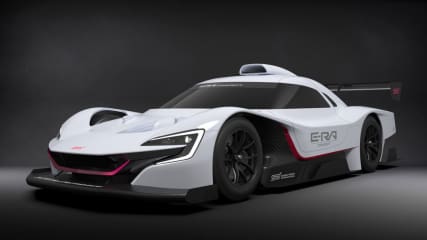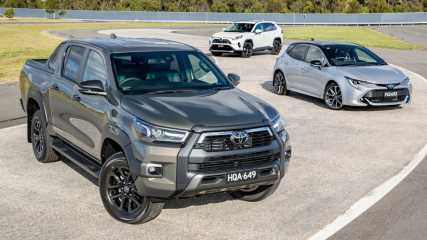1980 Subaru L Series Reviews
You'll find all our 1980 Subaru L Series reviews right here. 1980 Subaru L Series prices range from $2,200 for the L Series Dl 4wd to $4,070 for the L Series Dl 4wd.
Our reviews offer detailed analysis of the 's features, design, practicality, fuel consumption, engine and transmission, safety, ownership and what it's like to drive.
The most recent reviews sit up the top of the page, but if you're looking for an older model year or shopping for a used car, scroll down to find Subaru dating back as far as 1980.
Or, if you just want to read the latest news about the Subaru L Series, you'll find it all here.
Subaru Reviews and News
.jpg)
Kia Sportage GT-Line vs Mitsubishi Outlander Exceed vs Subaru Forester 2.5i-S vs Hyundai Tucson Highlander N Line 2022 comparison review
Read the article
By Laura Berry · 16 Jan 2022
Who would win in a fight between the Hyundai Tucson, Kia Sportage, Mitsubishi Outlander, and Subaru Forester? We brought them all together and now we know.
.jpg)
Will Toyota and Subaru beat Hyundai to the performance EV punch? Solterra and bZ4X siblings get respective STI and GR Sport makeovers - hinting at a sporty electric future
Read the article
By Tom White · 14 Jan 2022
Toyota and Subaru jointly show performance-branded concepts of their new EVs - but hardly any performance enhancements confirmed.

Next-generation Subaru WRX STI to go electric? New motorsport concept hints at future electric powertrain for WRX later this decade
Read the article
By Tim Nicholson · 14 Jan 2022
Revealed at this year's Tokyo Auto Salon, the STI E-RA Concept has been developed as part of the STI E-RA Challenge Project, a "near-future" motorsport study that aims to develop experience of new powertrain tech "in the world of motorsports in this carbo

The Kia versus Hyundai sales battle heated up in 2021. But which two brands came to spoil the party?
Read the article
By Tim Nicholson · 07 Jan 2022
Just a couple of months ago, Hyundai and Kia sales were neck and neck in Australia, making for a serious battle between the Korean sister brands.Sales figures to the end of September 2021 showed that Kia was trailing Hyundai by just over 850 units - 53,31

2021 new-car sales results: Toyota HiLux edges Ford Ranger as Australia's best-selling car, with RAV4 and Corolla not far behind
Read the article
By Tim Nicholson · 06 Jan 2022
The global pandemic and stock and delivery issues caused by semi-conductor shortages have not dented Australian new-car sales, with 1,049,831 registrations recorded in 2021, marking a 14.5 per cent increase over 2020.The strong sales result comes as buyer

Rugged SUVs are cool again! Mazda CX-50, Haval Big Dog, Ford Bronco Sport, Subaru Forester Wilderness and other butch high-riders trying to convince you of their off-road chops
Read the article
By Tung Nguyen · 01 Jan 2022
SUVs used to be the rugged, go-anywhere option for those wanting to haul their family with some gear across treacherous terrain.Think back to the Jeep Cherokee of the mid-1980s, or the Ford Explorer of the 1990s, or even the Lamborghini LM002.But somewher

So-called 'self-charging' hybrid cars: Everything you need to know
Read the article
By Stephen Corby · 28 Dec 2021
Much like the equally revered and reviled mullet haircut - business at the front, party at the back - a hybrid is a combination of two different elements that go together like Vegemite and toast. When talking cars, a hybrid is the combination of a traditional petrol or diesel-powered internal-combustion engine (ICE) with a battery-powered electric motor (or two) to drive the wheels, creating a middle-point between emissions-causing and emissions-free driving.These vehicles are often misconstrued and occasionally even advertised as 'self-charging', but be mindful these are very much just that middle-point, and will not charge their electric drivetrains without the intervention of the internal combustion drivetrain at some stage.The main benefit of a hybrid electric vehicle, in case you haven’t already guessed, is that it isn’t always using the ICE, which pleasingly cuts down both your fuel costs, and the carbon emissions that come out of your car’s tailpipe. If you’ve ever wondered “How does a hybrid car work?”, the answer is simple - although first, there are a few different types of hybrids that you need to know about. How a plug-in hybrid electric vehicle (PHEV) works is right there in the title: it needs to plug in to an external power source, like a wallbox charger or a domestic power socket, to charge its batteries, and is capable of driving in emissions-free EV mode (on average 50-60km, but this number can be higher or lower, depending on the size of the vehicle’s battery). There’s also what’s known as a “mild hybrid”. These have a starter-generator - an engine starter motor that also acts as an electricity generator - which is able to send energy back into the car’s battery. Although the ICE is constantly running in a mild hybrid, the electrical assistance it receives does help the car’s fuel economy (in a mild sense, of course).A standard hybrid, often known as a “series-parallel hybrid”, has a smaller battery, and it doesn’t need to plug-in to an external power source. It can typically operate at speeds of up to 40km/h, and distances of 2km, before the ICE kicks in.The battery in this type of hybrid could be seen as self-charging (see below), which typically happens via a process called “regenerative braking”. This is when kinetic energy is created as a car slows down, and that energy is harnessed and sent either directly to the electric motor that drives the wheels, or to the vehicle’s battery to be stored for future use. The ICE can also supply supplemental recharging of the battery by acting as a generator while either in motion or idling. As such, it is misleading to describe these vehicles as 'self-charging' given there is always a need for an internal combustion engine to facilitate charging of the electric drivetrain.Ever been on the road and noticed another car that seem to turn its engine off while idling at the lights, only to start back up again once it’s time to keep moving? This is because hybrids come with a stop/start function that switches the engine off when coasting slowly or when stopped, saving on fuel costs and cutting down on harmful emissions in the process. (Non-hybrids can also pull off this trick in more modern vehicles.)A common worry among drivers considering an electric vehicle (EV) is range anxiety, aka the fear the battery will run out of charge somewhere inconvenient before you’ve had a chance to recharge it. But by having an ICE to back-up the battery-powered electric motor in a hybrid, this has next to no chance of happening, as long as you’ve still got some petrol in the tank, of course (and it’s a lot easier to find a place to fill up with fuel).Electric motors produce maximum torque from zero revs, which means you get instant response and power from the throttle. The combination of ICE and electric motor means the petrol tank can be smaller and lighter, which also adds to a hybrid’s overall efficiency. Despite what impression your smug friends may be under, hybrid vehicles aren't the ultimate environmental solution. They are a big step in the right direction, but still require a lot of resources to build, and still emit some carbon and other harmful elements from their tailpipe.Hybrids are typically more expensive than equivalent ICE vehicles, but as more models enter the Australian market, prices will invariably drop, and price parity should be reached between hybrids and other EVs in the next few years. The battery packs used to power electric motors are on the heavy and large size, and they’re typically stashed in the lower rear of EVs. This can result in less luggage space in the boot, which isn’t an ideal result, especially if you have a family who like to travel as if they’re moving house every time they hop in the car. Battery packs in cars are typically guaranteed for around eight years, but the fact remains that they will degrade over time. This means that a battery pack will struggle to hold a charge more and more as the years progress, meaning more reliance on the ICE, which probably goes against why you bought a hybrid in the first place. Price: From $36,070, plus on-road costsPrice: From $35,490, plus on-road costsPrice: From $35,690, plus on-road costsPrice: From $39,990, plus on-road costsPrice: From $91,760, plus on-road costs
.jpg)
2022 Subaru Outback price and features: Skoda Superb Scout rival gets more expensive in the new year
Read the article
By Tung Nguyen · 18 Dec 2021
Subaru has given its Outback high-riding wagon range a light refresh for 2022, tweaking specification and adding a new special-edition variant, but also raising prices across the board.Now priced at $40,690 before on-road costs, the entry-level unnamed Ou

Will a hybrid really save you money over a petrol engine? We compare the running costs and purchase price of the 2022 Subaru XV to find which is better for you in the long run
Read the article
By Neil Dowling · 18 Dec 2021
Subaru joined the electrification bandwagon a relatively short 20 months ago, adding a hybrid option to its Forester and XV SUV range that claimed similar power to its existing petrol models, but with less fuel consumption.No complaints there as it's part

Subaru BRZ 2022 sold out! New Toyota 86 twin off to a hot start in Australia as buyers flock to relatively affordable Japanese performance
Read the article
By Justin Hilliard · 13 Dec 2021
Subaru Australia has announced that the second-generation BRZ sports coupe has sold out




